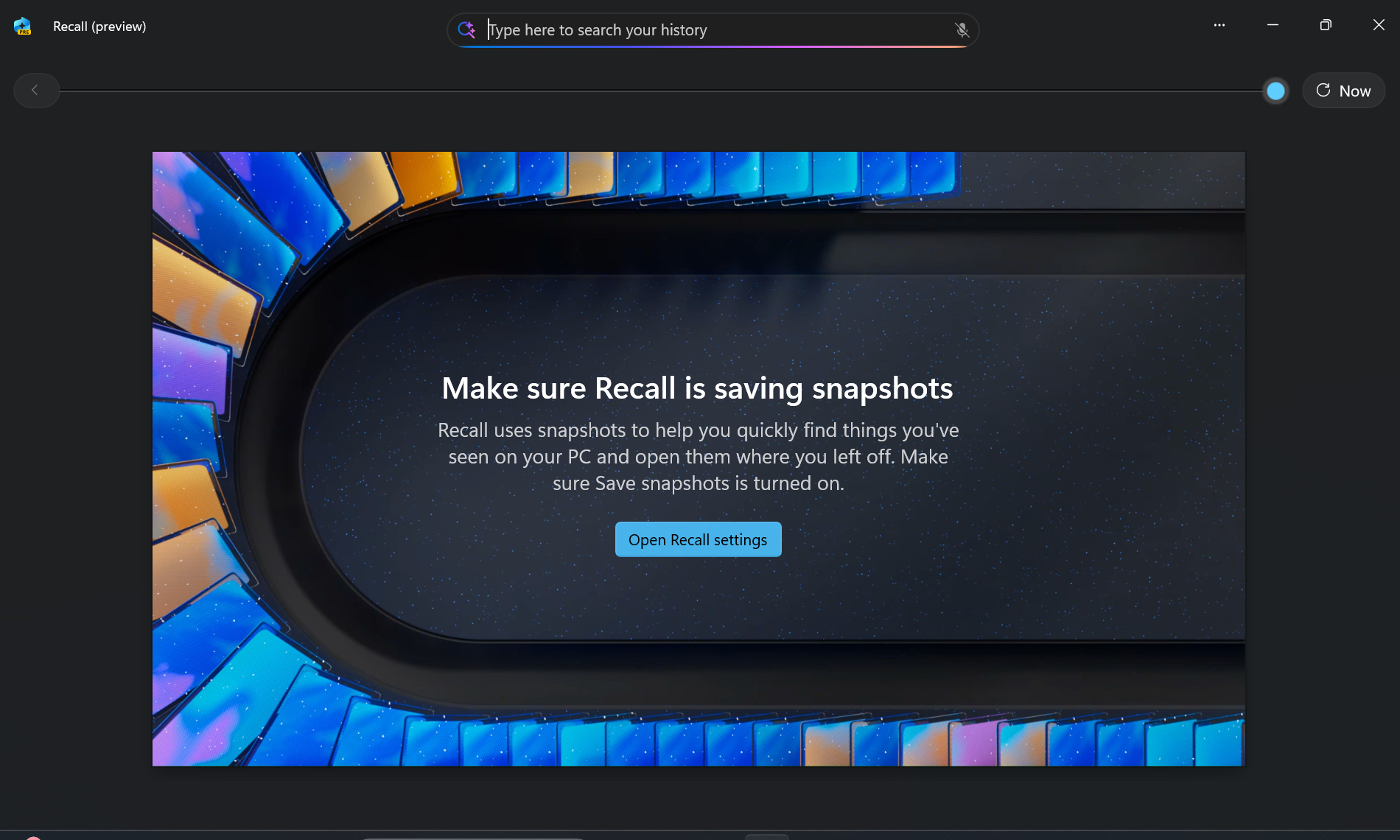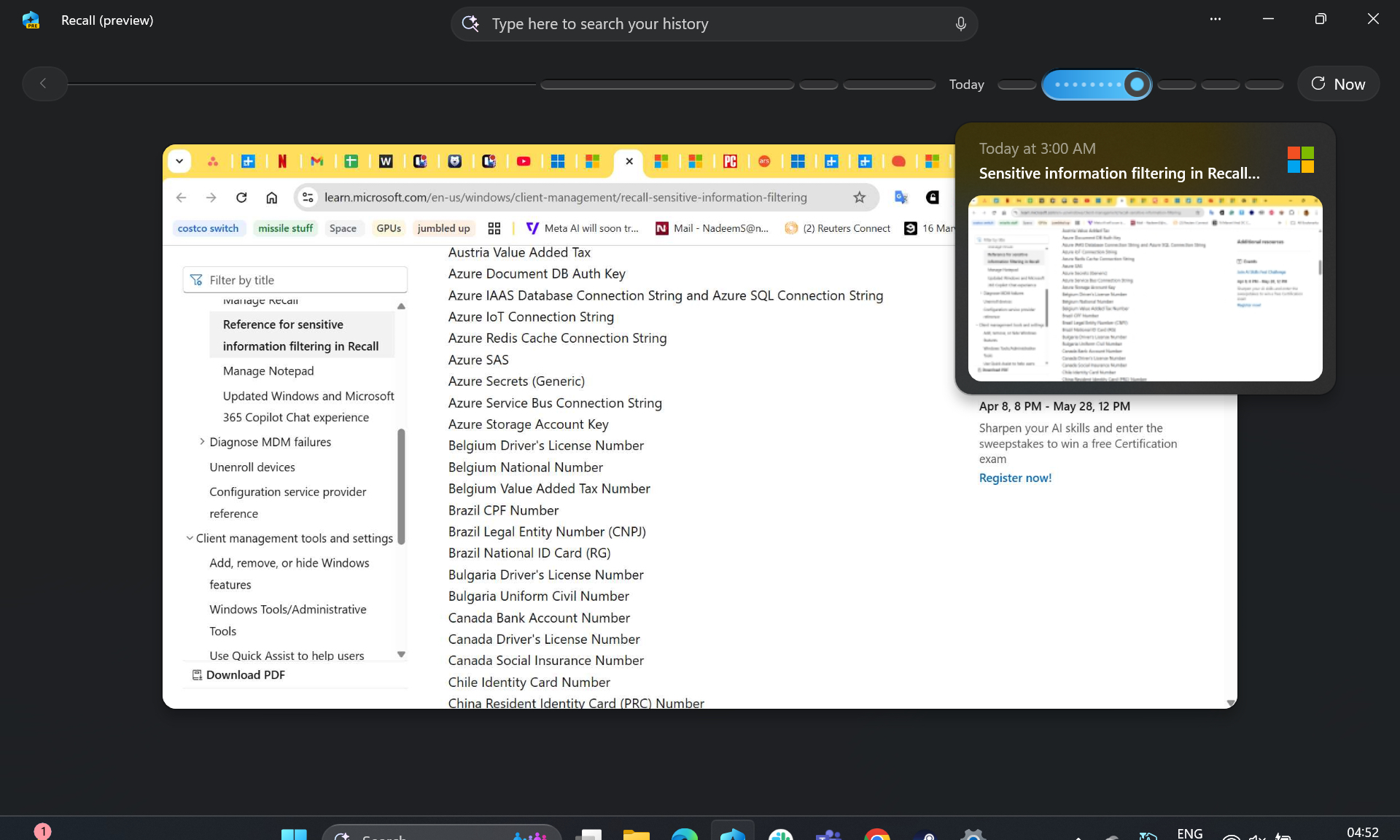Imagine a tool that takes an image of whatever appears on your computer’s screen, saves it locally, and lets you access it all like a time machine. A magical looking glass for the computing past. That’s essentially what Microsoft’s Recall is all about. Yet, when it was first introduced, it stirred up a security storm.
Microsoft pulled its release plans, fortified the security guardrails, and relaunched it a few weeks ago. This time around, Recall got a minor-but-amazingly practical upgrade. The best part? Instead of having you scrub through a long timeline of pictures, you can simply search through the entire activity history with words.
All those perks come at a steep processing price, both in terms of system resources and AI chops. So much that the only machines that support Recall need a Copilot+ branding and a processor launched within the past year, or so. The experience, however, is shockingly good.
What is Recall?

In Microsoft’s words, Recall lets you “quickly find and jump back into what you have seen before on your PC.” But before any of that happens, do keep in mind that it’s an opt-in process, and when you enable it, you need to biometrically verify your identity (face unlock or fingerprint scan) to access the history.
Next, your PC must meet the system requirements, too. For recall, you need a Copilot+ PC that has a dedicated AI chip offering over 40 TOPS output, 16GB of RAM, 256GB storage (of which 50GB must be free at the very minimum), active device encryption, and Windows Hello sign-in enabled.
Recall is also tied deeply to your web browsing activity, and as such, it needs a compatible browser. Broadly, it works with Chromium-based options, such as Edge, Chrome, Opera, and Firefox. But why are browsers important when Recall is essentially saving your entire screen activity?

First, it doesn’t log screenshots of your incognito or private mode browsing. More importantly, you can limit it from saving screenshots of certain websites, using a system of filters. Think of your banking activities or secure communications.
Likewise, you can also exclude certain apps from getting visually cataloged into a digital ledger. Those exceptions are extremely important, especially for folks who think the idea of a “snapshot everything” tool is too risky.
For the sake of privacy, I disabled Recall for WhatsApp to protect my personal chats and Adobe Reader, because I regularly handle confidential papers. You can choose to pause/resume Recall’s snapshot gathering — briefly or permanently – from a dedicated shortcut in the system tray.
How does it help me?

Microsoft is selling the idea of Recall as a photographic memory for your PC. The idea is almost loathsome for any normal person who despises the concept of all their computing activity being recorded in the form of crisp snapshots. AI skeptics would absolutely run away from it.
I, a man of forgetful ways and critic of poorly-designed apps, love this. My daily routine entails reading and writing words. Lots and lots of them. From long articles in Docs and notes in a tiny scratchpad to detailed pitches in email and daily chat with work colleagues, most of my waking time revolves around words.
I believe I have a decent memory of events, but not so much with exact terms like “Embargoed until May 16, 6AM PT / 9AM CET” or “Microsoft meeting with John scheduled for April 9. Does 6AM ET or 5PM ET sound good?” It’s not scientifically possible either to remember it all, even though I have a vague recollection of the main event.

This is where Windows Recall and its image recognition come to the rescue in a very controlled fashion. I remember having a brief chat with a source named John, but couldn’t quite remember where the transcripts were saved. I went back to Recall, looked up the name, and found just what I was looking for.
From the looks of the snapshot, it was a browser tab, but I no longer had it active. This is where Recall offered two routes to recover it. First, it offered an outbound URL button to open the webpage in a browser. Alternatively, the Click To Do system lets me copy-paste the conversation directly from the saved snapshot.

It even pulled information from a diagnostic test and directly guided me to Microsoft’s official Get Help dashboard with a single click. That’s impressive stuff.
Depending on the content you have selected in a Recall snapshot, you will also see contextual actions such as summarizing or rewriting the text passage. You can directly choose to open it in Notepad, or pick from any app of your choice.

For example, I was recently looking up a recipe and forgot to bookmark it. With Recall, I recovered it and directly moved the wall of text to Copilot, where it was neatly rewritten across headings and bullet points, like a cookbook.
These impressive capabilities are driven by Optical Character Recognition (OCR), powered by the AI accelerator chip on a Windows machine. Everything you search in Recall is processed contextually, and the results you are shown are divided across text and images.

The safety protocols
Microsoft has also built a set of safety features around sensitive information. For example, it won’t save details such as license, credit card, account, personal identification, tax filing, citizen registration, and license numbers.
I tried two of my banking operators and a government website where my national identity card copies are accessible, and they didn’t appear in the Recall snapshots. The list covers a healthy bunch of documents used across North America, Europe, and Asian countries, but it’s not all-encompassing.

For the sake of added precaution, you can open such web portals in incognito mode or private windows. Alternatively, you can simply set those websites within Recall’s filters, and their snapshots will never be saved in the first place.
Furthermore, the Recall app will give you an option to delete all images belonging to a certain website or app, in one go. Finally, there is an auto-delete function, where you can set the erase all snapshots at a cadence of 30, 60, 90, and 180 days. Of course, you can wipe the slate clean at your own discretion.
Another huge respite for me? The poor search system in apps. From Slack to Google Drive, the search system in these platforms often leaves me frustrated. Plus, if you don’t pay for a premium, the free user limits mean you lose your chat data due to the auto-delete protocols.

Recall offers a fantastic way to not just overcome the poor search system in virtually any app that runs on your computer, but also does a much better job at it. It fared better at helping me find the right Docs file in a list of thousands that I have hoarded over the years and refuse to delete.
Contextual understanding is a huge benefit here. For example, if you work across different apps, the search results at the top will let you narrow down the results. For example, you can only look for an item in Outlook if a match is found in the email client, among a bunch of other apps. This approach saves a lot of time.
Why are experts spooked?
Security experts are skeptical about the idea, and rightfully so. Nick Hyatt, Director of Threat Intelligence at Blackpoint Cyber, told me that Recall is a great idea, but also an awful one for a lot of reasons.

He pointed out how the feature logs every single aspect of your digital life, from personal communications to files and what you look up on the web. The stakes are even higher for situations such as domestic abuse.
“A categorized, searchable database of every activity conducted by a user could literally result in people dying should attempts to get help be discovered,” Hyatt pointed out. Plus, the cyber threat ecosystem is an ever-evolving field, so the risks persist.

“Recall will be heavily targeted by attackers because of the goldmine of user data it contains,” Nate Warfield, Director of Threat Research & Intelligence at Eclypsium, told Digital Trends. “The repercussions of being able to steal what is essentially a complete history of what a user does on their machine are near impossible to comprehend.”
Jeff Williams, co-founder and CTO at Contrast Security, expressed confidence in the kind of security protections Microsoft has put in place for Recall. It is encrypted and lives behind biometric authentication.
Even if you are running it in the background and randomly pull up the dashboard, you will only be able to see the timeline after going through the security check. “For now, I don’t see how this is much more risky than log files stored locally,” Williams pointed out, adding that only extensive penetration testing will reveal the real picture of Recall.

For an average user like me, I believe Recall is a deeply rewarding feature. And yes, every layer of security that is added to the system is a welcome change. The risk of infostealers and malware with OCR capabilities will persist, but going past the Recall guardrails won’t be easy, especially with safety features such as just-in-time decryption.
You can always stay a step ahead and block Recall from logging your activity across specific websites and apps to be on the safe side. You can go with the auto-delete protocol, or even batch delete all snapshots from a certain website or app from Recall, in case you didn’t already filter it out.
In the wake of my tests, I found Recall to be one of the most practically rewarding AI features, right up there with Deep Research. What it really needs is to bring down the access walls (read: price), or wait for Copilot+ PCs to get a bit cheaper. The new 12-inch Microsoft Surface Pro is a great start, but more brands need to follow suit.




